Excerpts from Jim Conrad's
Naturalist Newsletter
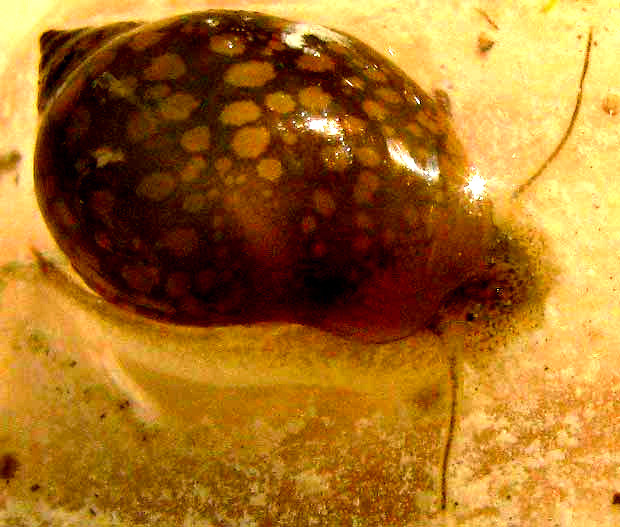
from the December 22, 2013 Newsletter issued from the Frio Canyon Nature Education Center in the valley of the Dry Frio River in northern Uvalde County, southwestern Texas, on the southern border of the Edwards Plateau; elevation ~1750m (~5750 ft); N29.62°, W99.86°; USA
TADPOLE SNAIL
Maybe the most common aquatic snail in the little Dry Frio River is one with a ¼-inch-long (7mm) shell, shown above.
Actually, in most parts of the Dry Frio I can't find any snails at all, probably because the streambed and aquatic vegetation are so heavily coated with calcium-rich marl that a snail can't get a decent foothold, or maybe because too much marl would have to be ingested to get the organic detritus or algae it wants to feed on. However, in the river's stagnant pools and arms the marl isn't as thick, and there snails turn up, especially the one shown above. With the broadly oval shape and spottiness of its shell and broad head, it's easy to distinguish from other snail species. Below, you can see the shell from below, displaying the teardrop-shaped, unusually long and open "aperture" through which the snail's body extends:
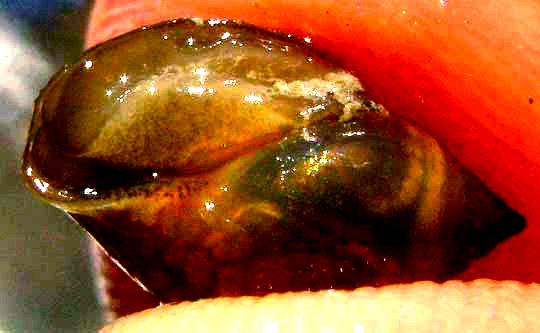
A couple of these snails were given homes in fishbowls in Juniper House, and below you can see what one looks like through glass as it climbs the wall:
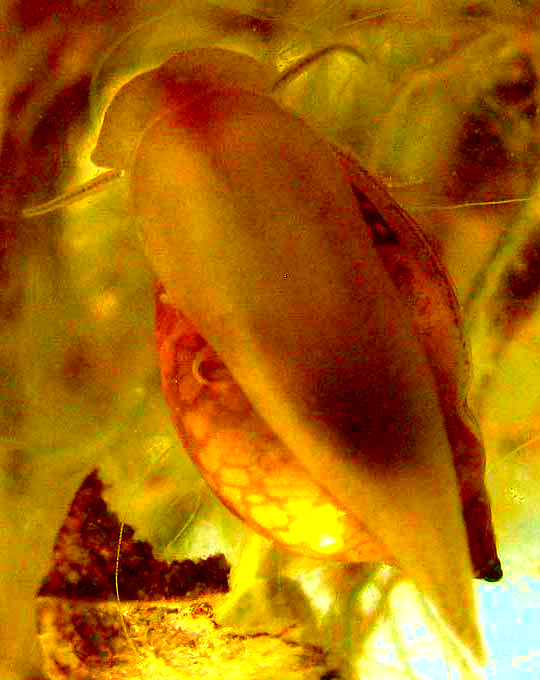
Often to determine a snail's identity you need to dissect it, but I feel fairly confident about who this one is just based on the general features noted above, and the fact that so many identified snails on the Internet look like it. It's PHYSELLA ACUTA, which goes by many names, including Tadpole Snail, Bladder Snail, Left-handed Pond Snail, Pewter Physa and Protean Physa. Maybe the Tadpole name arises from the fact that some tadpoles bear spots like this snail's shell. The reason the snail has so many common names is that it occurs in freshwater practically worldwide and in many places is the most commonly occurring species. It's so cosmopolitan that it's hard to say where it's native to, or maybe it's native to everyplace.
Another reason for confidence in the name is that snail expert Richard Fullington has surmised that the Tadpole Snail is "... probably the most common freshwater snail in the southwest US" and "probably occurs in every Texas county."
Finally, snail species come in right-hand and left-hand models. Tadpole Snails are listed as "sinistral," which means that if the shell is held with the aperture facing the observer and with the spire pointing upward, the aperture falls on the left-hand side. That checks out with our snail.
Tadpole Snails are so common because they are highly adaptable and tough. They can live in freshwater rivers, streams, lakes, ponds, swamps, manmade reservoirs, warm water discharges of power plants, and ditches. They survive well under temporary temperature extremes and high pollution levels. In fact, they've been recorded as serious pests in greenhouses and filtering vegetation at sewage treatment plants. Also, they mature rapidly and have a high reproductive rate. They've been called "the fruit fly of malacology," malacology being the study of mollusks.
They eat dead plant and animal matter, or detritus, their preferred grazing sites being submerged plant surfaces.
from the March 3, 2014 Newsletter issued from the Frio Canyon Nature Education Center in the valley of the Dry Frio River in northern Uvalde County, southwestern Texas, on the southern border of the Edwards Plateau; elevation ~1750m (~5750 ft); N29.62°, W99.86°; USA
SNAIL EGGS
Turning over rocks in one of the Dry Frio's many shallow and very modest rapids, nowadays beneath many rocks you find dragonfly naiads, stonefly larvae and the like, plus often there are interesting little gobs of transparent, jellylike substance adhering to the stones' submerged undersides, as shown below:
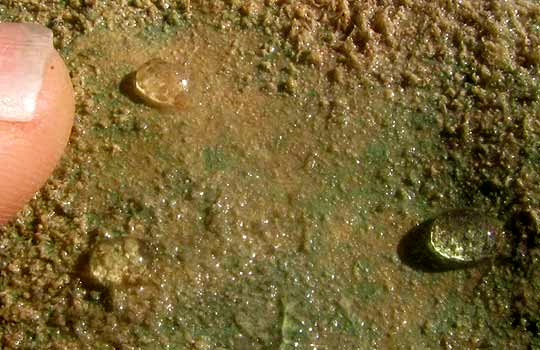
Beneath a hand lens you see that each blob contains several creamy-white items appearing to be suspended in their own orbs of gelatinous material, as seen below:
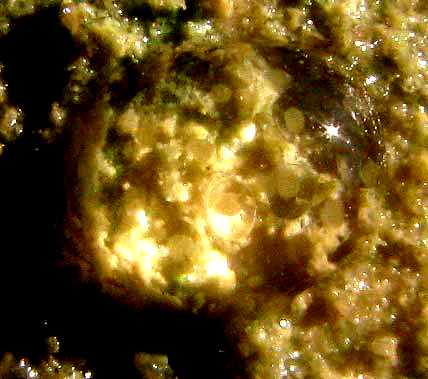
I saw this kind of thing when I was a kid with an aquarium back on the farm in Kentucky, and I knew that they were snail eggs. When you do a search engine image-search on "snail eggs" you see that snail eggs come in many conditions, sometimes forming clusters like tiny, dry ping-pong balls stuck to grass stems, some like clumping grains of pinkish sand, and others in different forms, including having the eggs embedded in jelly. Some jelly-producing species deposit narrow bands of jelly, others round daubs of it, some croissant-shaped, etc.
By far the most commonly occurring aquatic snail in the Dry Frio is what we've called the Tadpole Snail. Picture's of Tadpole Snail eggs on the Internet look pretty much like ours, so probably our picture shows Tadpole Snail eggs. Tadpole Snail egg packages contain between 20-400 eggs, usually less than 50, so our globs are particularly small. In warm climates the eggs hatch in a couple of weeks. The embryo and its spherical, gelatinous egg material is referred to as an egg capsule. Egg capsules are in turn suspended in a gelatinous egg mass.
Tadpole Snails are hermaphrodites; they can mate with one another, or with themselves.